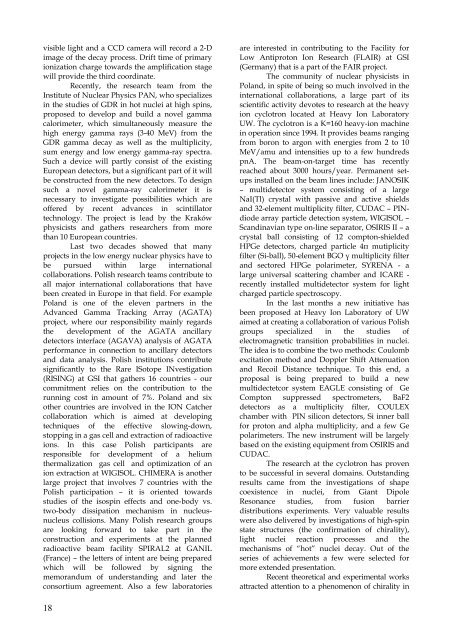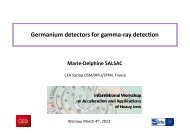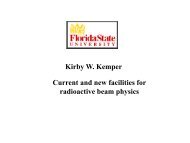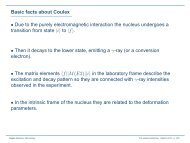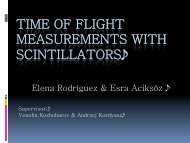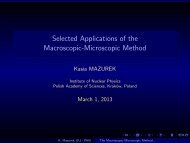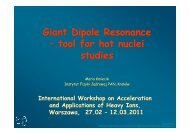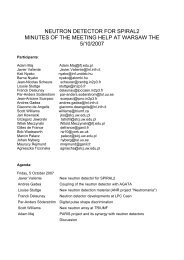nuclear physics in poland 1996 â 2006
nuclear physics in poland 1996 â 2006
nuclear physics in poland 1996 â 2006
- No tags were found...
Create successful ePaper yourself
Turn your PDF publications into a flip-book with our unique Google optimized e-Paper software.
visible light and a CCD camera will record a 2-Dimage of the decay process. Drift time of primaryionization charge towards the amplification stagewill provide the third coord<strong>in</strong>ate.Recently, the research team from theInstitute of Nuclear Physics PAN, who specializes<strong>in</strong> the studies of GDR <strong>in</strong> hot nuclei at high sp<strong>in</strong>s,proposed to develop and build a novel gammacalorimeter, which simultaneously measure thehigh energy gamma rays (3-40 MeV) from theGDR gamma decay as well as the multiplicity,sum energy and low energy gamma-ray spectra.Such a device will partly consist of the exist<strong>in</strong>gEuropean detectors, but a significant part of it willbe constructed from the new detectors. To designsuch a novel gamma-ray calorimeter it isnecessary to <strong>in</strong>vestigate possibilities which areoffered by recent advances <strong>in</strong> sc<strong>in</strong>tillatortechnology. The project is lead by the Krakówphysicists and gathers researchers from morethan 10 European countries.Last two decades showed that manyprojects <strong>in</strong> the low energy <strong>nuclear</strong> <strong>physics</strong> have tobe pursued with<strong>in</strong> large <strong>in</strong>ternationalcollaborations. Polish research teams contribute toall major <strong>in</strong>ternational collaborations that havebeen created <strong>in</strong> Europe <strong>in</strong> that field. For examplePoland is one of the eleven partners <strong>in</strong> theAdvanced Gamma Track<strong>in</strong>g Array (AGATA)project, where our responsibility ma<strong>in</strong>ly regardsthe development of the AGATA ancillarydetectors <strong>in</strong>terface (AGAVA) analysis of AGATAperformance <strong>in</strong> connection to ancillary detectorsand data analysis. Polish <strong>in</strong>stitutions contributesignificantly to the Rare ISotope INvestigation(RISING) at GSI that gathers 16 countries - ourcommitment relies on the contribution to therunn<strong>in</strong>g cost <strong>in</strong> amount of 7%. Poland and sixother countries are <strong>in</strong>volved <strong>in</strong> the ION Catchercollaboration which is aimed at develop<strong>in</strong>gtechniques of the effective slow<strong>in</strong>g-down,stopp<strong>in</strong>g <strong>in</strong> a gas cell and extraction of radioactiveions. In this case Polish participants areresponsible for development of a heliumthermalization gas cell and optimization of anion extraction at WIGISOL. CHIMERA is anotherlarge project that <strong>in</strong>volves 7 countries with thePolish participation – it is oriented towardsstudies of the isosp<strong>in</strong> effects and one-body vs.two-body dissipation mechanism <strong>in</strong> nucleusnucleuscollisions. Many Polish research groupsare look<strong>in</strong>g forward to take part <strong>in</strong> theconstruction and experiments at the plannedradioactive beam facility SPIRAL2 at GANIL(France) – the letters of <strong>in</strong>tent are be<strong>in</strong>g preparedwhich will be followed by sign<strong>in</strong>g thememorandum of understand<strong>in</strong>g and later theconsortium agreement. Also a few laboratoriesare <strong>in</strong>terested <strong>in</strong> contribut<strong>in</strong>g to the Facility forLow Antiproton Ion Research (FLAIR) at GSI(Germany) that is a part of the FAIR project.The community of <strong>nuclear</strong> physicists <strong>in</strong>Poland, <strong>in</strong> spite of be<strong>in</strong>g so much <strong>in</strong>volved <strong>in</strong> the<strong>in</strong>ternational collaborations, a large part of itsscientific activity devotes to research at the heavyion cyclotron located at Heavy Ion LaboratoryUW. The cyclotron is a K=160 heavy-ion mach<strong>in</strong>e<strong>in</strong> operation s<strong>in</strong>ce 1994. It provides beams rang<strong>in</strong>gfrom boron to argon with energies from 2 to 10MeV/amu and <strong>in</strong>tensities up to a few hundredspnA. The beam-on-target time has recentlyreached about 3000 hours/year. Permanent setups<strong>in</strong>stalled on the beam l<strong>in</strong>es <strong>in</strong>clude: JANOSIK– multidetector system consist<strong>in</strong>g of a largeNaI(Tl) crystal with passive and active shieldsand 32-element multiplicity filter, CUDAC – PINdiodearray particle detection system, WIGISOL –Scand<strong>in</strong>avian type on-l<strong>in</strong>e separator, OSIRIS II – acrystal ball consist<strong>in</strong>g of 12 compton-shieldedHPGe detectors, charged particle 4π mutiplicityfilter (Si-ball), 50-element BGO γ multiplicity filterand sectored HPGe polarimeter, SYRENA - alarge universal scatter<strong>in</strong>g chamber and ICARE -recently <strong>in</strong>stalled multidetector system for lightcharged particle spectroscopy.In the last months a new <strong>in</strong>itiative hasbeen proposed at Heavy Ion Laboratory of UWaimed at creat<strong>in</strong>g a collaboration of various Polishgroups specialized <strong>in</strong> the studies ofelectromagnetic transition probabilities <strong>in</strong> nuclei.The idea is to comb<strong>in</strong>e the two methods: Coulombexcitation method and Doppler Shift Attenuationand Recoil Distance technique. To this end, aproposal is be<strong>in</strong>g prepared to build a newmultidectetcor system EAGLE consist<strong>in</strong>g of GeCompton suppressed spectrometers, BaF2detectors as a multiplicity filter, COULEXchamber with PIN silicon detectors, Si <strong>in</strong>ner ballfor proton and alpha multiplicity, and a few Gepolarimeters. The new <strong>in</strong>strument will be largelybased on the exist<strong>in</strong>g equipment from OSIRIS andCUDAC.The research at the cyclotron has provento be successful <strong>in</strong> several doma<strong>in</strong>s. Outstand<strong>in</strong>gresults came from the <strong>in</strong>vestigations of shapecoexistence <strong>in</strong> nuclei, from Giant DipoleResonance studies, from fusion barrierdistributions experiments. Very valuable resultswere also delivered by <strong>in</strong>vestigations of high-sp<strong>in</strong>state structures (the confirmation of chirality),light nuclei reaction processes and themechanisms of “hot” nuclei decay. Out of theseries of achievements a few were selected formore extended presentation.Recent theoretical and experimental worksattracted attention to a phenomenon of chirality <strong>in</strong>18


